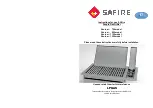
POWX1190
EN
Copyright © 2020 VARO NV
S t r a n a
|
5
www.varo.com
▪
If devices are provided for the connection of dust extraction and collection facilities, ensure
these are connected and properly used. Use of these devices can reduce dust related
hazards.
5.4
Power tool use and care
▪
Do not force the power tool. Use the correct power tool for your application. The correct
power tool will do the job better and safer at the rate for which it was designed.
▪
Do not use the power tool if the switch does not turn it on and off. Any power tool that
cannot be controlled with the switch is dangerous and must be repaired.
▪
Disconnect the plug from the power source before making any adjustments, changing
accessories, or storing power tools. Such preventive safety measures reduce the risk of
starting the power tool accidentally.
▪
Store idle power tools out of the reach of children and do not allow persons unfamiliar with
the power tool or these instructions to operate the power tool. Power tools are dangerous
in the hands of untrained users.
▪
Maintain power tools. Check for misalignment or sticking of moving parts, breakage of
parts and any other condition that may affect the power tool’s operation. If damaged, have
the power tool repaired before use. Many accidents are caused by poorly maintained
power tools.
▪
Keep cutting tools sharp and clean. Properly maintained cutting tools with sharp cutting
edges are less likely to stick and are easier to control.
▪
Use the power tool, accessories and tool bits etc., in accordance with these instructions
and in the manner intended for the particular type of power tool, taking into account the
working conditions and the work to be performed. Use of the power tool for operations
different from intended could lead to a hazardous situation.
5.5
Service
▪
Have your power tool serviced by a qualified repair person using only identical
replacement parts. This will ensure that the safety of the power tool is maintained.
6 ADDITIONAL SAFETY INSTRUCTIONS FOR HAMMER DRILLS
▪
Check the voltage (volt) marked on the rating plate.
▪
When using cable drums, run all the cable off the drum. Minimum conductor cross section:
1.0 mm².
▪
When using the electric hammer drill outdoors, connect to the power supply with a type
H07RN-F 3G 1.5 mm² extension cable and rain-water-protected plugs in proper working
order.
▪
Make sure of your footing on ladders and scaffolding when drilling free-handed.
▪
Use a line detector to localize lines in walls with concealed electric, water or gas lines.
Avoid touching live components or conductors.
▪
Wear ear muffs to protect your hearing. Loss of hearing can be a gradual process!
▪
Wear goggles and use a dust mask on jobs generating dust.
▪
Do not use in areas where there are vapours or flammable liquids.
▪
Always pull the plug out of the socket before cleaning or making changes to the machine.
▪
Protect the power cable from damage. Oil and acid can damage the cable.
▪
Never overload the machine.
▪
Secure all workpieces sufficiently.
▪
Important!
It is imperative to follow all national safety regulations concerning installation,
operation and maintenance.
▪
Chisel bits and drill bits may be flung out of the machine accidentally and cause serious
injury:
▪
Before starting to work, always check that the chisel or drill bit is property locked in the
chuck.
▪
Examine the chuck regularly for signs of wear or damage.




























